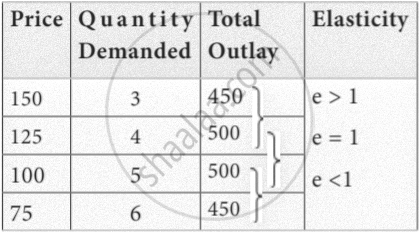Advertisements
Advertisements
Question
What are the methods of measuring Elasticity of demand?
Solution
There are three methods of measuring the elasticity of demand.
- The percentage method:
Ep = `"ΔQ"/"ΔP"xx P/Q`
It is also known as the ratio method when we measure the ratio as
Ep = `"%ΔQ"/"%ΔP"`
% ∆Q = perCentage change in demand, %∆P = Percentage change in price.
- Total outlay method:
Marshall suggested that the simplest way to decide whether demand is elastic or inelastic is to examine the change in the total outlay of the consumer or total revenue of the firm.
Total revenue = Price × Quantity sold
TR = P × Q
Total outlay method:

Demand is elastic if there is an inverse relationship between price and total outlay, and direct relation means inelastic. Elasticity is unity when the total outlay is constant.
APPEARS IN
RELATED QUESTIONS
Income elasticity of demand for inferior goods is negative.
Explain the factors determining the elasticity of demand.
A consumer spends Rs 1,000 on a good priced at Rs10 per unit. When its price falls by 20 percent, the consumer spends Rs800 on the good. Calculate the price elasticity of demand by the Percentage method
Write short notes on the Proportional method of measuring the elasticity of demand.
A consumer spends Rs 200 on a good priced at Rs 5 per unit. When the price falls by 20 percent, he continues to spend Rs 200. Find the price elasticity of demand by percentage method.
What do you mean by a normal good?
What do you mean by complements? Give examples of two goods which are complements of each other.
Consider the demand curve D(p) = 10 − 3p. What is the elasticity at price `5/3` ?
The demand for salt is ______.
State whether the following statement is TRUE and FALSE.
Demand for luxuries is elastic.
State whether the following statement is TRUE and FALSE.
Unitary Elastic Demand rarely occurs in practice.
Define or explain the following concept:
Cross Elasticity of Demand
Define or explain the following concept:
Unitary Elastic Demand
Define price elasticity of demand.
Identify the correctly matched pair from the items in Column A by matching them to the items in column B:
| Column A | Column B |
| 1. Increase or decrease in demand for a commodity does not cause any change in its price. | (a) Effect on supply, in the case of Perfectly Elastic Demand. |
| 2. Increase or decrease in demand causes a change in the price of the commodity. Equilibrium quantity remains constant. | (b) Effect on demand, in the case of Perfectly Inelastic Supply. |
| 3. Increase or decrease in demand cause a change in the price of the commodity. Equilibrium quantity remains constant. | (c) Effect on demand, in the case of Perfectly Elastic Supply. |
| 4. Increase or decrease in demand for a commodity does not cause any change in its price. | (d) Effect on supply, in the case of Perfectly Elastic Demand. |
mention any two examples of composite demand.
As a result of 5% fall in the price of a good, its demand rises by 12%, the demand for the good will said be ______.
When change in price is greater than the change in quantity demand it is a case of elastic demand.
What is meant by elastic demand?
